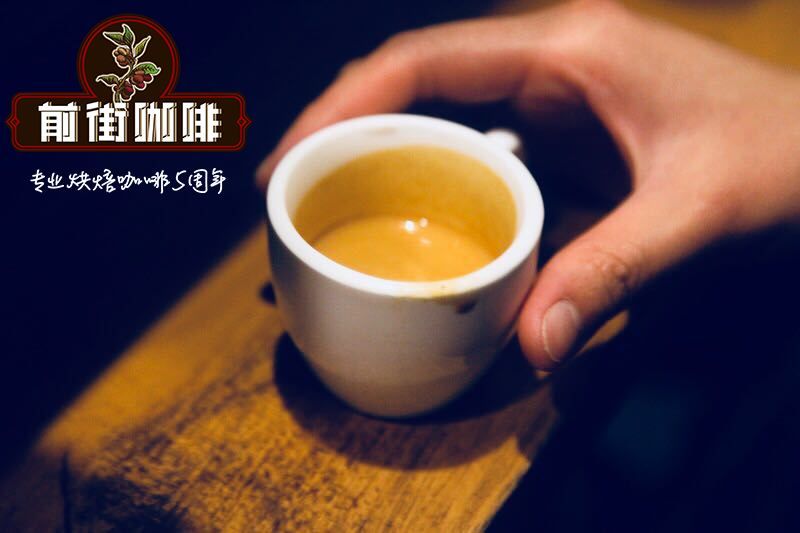Introduction to the classification of coffee varieties and the characteristics of coffee variety distribution
Coffee tree is a flowering plant of the genus Coffea of Rubiaceae. At present, there are about 120 species, ranging from small shrubs to 18-meter-tall trees. Wild coffee species grow irregularly in the tropics, and new species are still being discovered. Strictly speaking, only two major species of coffee are cultivated to produce coffee: Arabica coffee (Arabica) and Canifra coffee (English Canephora, often referred to as "Robusta coffee"). However, in order to meet the needs of domestic coffee consumption, a third species, Liberian coffee, has been planted in a small number of countries such as the Philippines.
Nearly 70% of the world's commercially grown coffee is Arabica coffee, with a total of 7 million tons of roasted coffee each year. Robusta coffee accounts for the rest of the market, mainly produced in Java, Sumatra and Vietnam in India, Indonesia and Vietnam, which contributes nearly half of the world's total production of Robusta coffee. It is the second largest coffee producer in the world after Brazil.
Robusta "means strong and healthy, and as the name suggests, robusta coffee has better disease resistance than Arabica coffee. Part of the reason is that Robusta coffee has a higher caffeine content and has a stronger inhibitory effect on small pests. Robusta coffee is characterized by higher fruit yield per unit harvest period, and its ripe fruit can hang on trees for a long time, compared with Arabica coffee that falls to the ground if it is not harvested in time. Robusta coffee beans are smaller and thicker than Arabica beans, thicker but slightly less flavored.
Arabica coffee plants bear more subtle fruit flavor, its varieties are widely distributed and clearly defined, and the appearance and style of Arabica coffee are distinctive. Most varieties of Arabica coffee are genetically mutated or improved by a cross between two patrilineal Arabica coffee, Tibica and bourbon. Tibica (usually Arabica) is the first coffee variety introduced from Ethiopia to Yemen and then to India. In 1718, Tibica species collected from Java were introduced into French Bourbon Island (now known as Reunion) 800km east of Madagascar in the Indian Ocean. Here the Tibica species abruptly became a new variety, that is, the later bourbon species. In today's coffee market, Tibica and bourbon are the largest varieties of Arabica coffee.
Some varieties are derived from natural gene mutations, while others are the products of artificial cross breeding or acquired breeding of native species. Arabica species are self-pollinating plants, and their genetic lineage should be quite pure. However, Tibika species and bourbon species have been brought to new countries, foreign climate conditions lead to natural gene mutations, and the characteristics of cultivated new varieties are mostly gratifying.
The story of robusta coffee is roughly the same, but it was not until 1895 that the species was officially classified into the botanical classification system (Arabica species was 1753). Robusta coffee is native to West Africa and has been grown in Java and spread all over the world. Like Arabica coffee, there are many varieties of robusta coffee, but most of them have a mediocre flavor and nothing to shine on.
Tibica (also known as Typica, English Tibica)
Tibica is the original species of all Arabica varieties. It is said that Tibika originated in southern Sudan, flourished in Ethiopia and was finally planted in Yemen for commercial production around the 7th century AD. Tibica was brought to the East Indies by the Dutch and was the first coffee variety to come to the West Indies, where Gabriel de Klee was planted in French Martinique in 1720.
The ripe fruit of Tibica is red. The yield of this variety is relatively low and its disease resistance is extremely poor, but its excellent cup test quality still makes it popular all over the world.
Bourbon (English name Bourbon)
Bourbon is the product of genetic mutation of the original Tybika species on the island of Reunion, and it is also the patrilineal and even grandfather line of many popular Latin American coffee species, including Kaddura, Kaduai, Pacas, New World, etc.
Kind of. Bourbon is still popular in Latin America today, crossing the ocean to Africa and taking root in Rwanda and Burundi. The ripe fruits of bourbon are mostly red, and there are also yellow or orange varieties. The output of bourbon is about 20% to 30% higher than that of Tibica; although the flavor is slightly sweeter and sometimes more balanced, the two varieties of coffee are generally very similar.
Katim (English name Catimor)
Katim is a hybrid of Kaddura and Timor-don't be confused with Kaddura and Kaduai. This highly resistant plant has the ability to resist coffee leaf rust, so it was widely planted in Latin American countries in the 1980s. Unfortunately, because the Timorese species (also known as the Alabasta species) is the product of a natural cross between the Tibica Arabica species and the Robusta species, although the latter can give it disease resistance, the delicate taste of the Arabica varieties has disappeared.
Kaduai (English Catuai)
Brazil bred Kaduai in the 1950s, which is a hybrid of Kaddura and the New World, with strong disease resistance and high yield. Like Kaddura, Kaduai's ripe fruit is naturally divided into red and yellow (I personally prefer the former). Kaduai is famous for its acidity and is common in most Central American countries.
Kaddura (English Caturra)
In the 1930s, a Bourbon gene mutation was found near the Brazilian city of Kadura, and it was named Kaddura. Kaddura's yield is high, and compact plants are easy to pick, but if planted at lower elevations, this characteristic becomes its own worst enemy-coffee becomes quite light here, so the weight of the fruit itself can crush the plant. If planted in a high altitude environment (more than 1200 meters), Kaddura's coffee quality and yield can be better guaranteed. Kaddura is a common variety of Central American coffee belts.
Rose Summer (English Geisha)
Rosa, with slightly slender fruits and leaves, is a genetic mutant of Tibika and is said to have originated in the small town of Rosa in southwestern Ethiopia. Rose seeds were shipped to Tanzania in the 1930s and to Costa Rica in the 1950s. These two countries are the only important growers of Rosa outside Panama-although Panama is the best spokesman for Rosa.
In the high-altitude growing areas of Panama, Rosa proved to the world that it is an undisputed variety of coffee with tropical flavor, citrus and tea. Good coffee is loved by everyone, and I sincerely hope that Rosa can go to other countries.
Marago Gippe
Marago Gippe, thought to be a natural genetic mutant of Tibika, was first found near Marago Zeppe (just one word short) in the Bahia region of Brazil. Marago Gippe is a well-known large coffee bean and a patrilineal variety of Pacamara.
New World (English Mundo novo)
New World (also known as Mondonovo) is a hybrid of Bourbon and Tibica, which first appeared in the 1940s and is still widely welcomed by Latin American coffee producers today. Its disease resistance and yield are better than bourbon and Tibika, but at the cost of insufficient flavor complexity.
Pacamara (English name Pacamara)
The Pacamara, bred by El Salvador in the late 1950s, is a hybrid of Pacas and Marago Gippe and is now in high demand. Similar to Maragogippe, it is large-usually twice the size of standard bourbon beans-but produces mediocre yields. Pacamara is widely praised for its clean acidity and fresh scent of flowers, and the higher the altitude, the more advantageous it is to plant it.
Pacas (English name Pacas)
Pacas, a natural genetic mutant of bourbon, was discovered in El Salvador in 1949. Its compact plant can withstand relatively low altitude conditions, so people use it to cross with the opposite Malaggippe.
Tex.
The Salvadoran Coffee Institute (ISIC) began artificial breeding of bourbon plants in 1949. After 28 years of unremitting efforts, it finally bred a short Tex species in 1977, also known as the "improved version of bourbon". Although the yield of Tex is relatively low, the long breeding process makes its complex flavor very attractive and its taste quite full. Farmers in El Salvador, Honduras and Guatemala admire this variety and try to use it to improve the quality of their coffee.
SL-28
SL-28 's "SL" is an acronym for Scott Lab, a technology company hired by the Kenyan government since the 1930s to identify local coffee varieties that are most suitable for large-scale cultivation. SL-28 has become the benchmark variety in several planting areas of Kenya because of its strong blackcurrant flavor. SL-28 should be planted in high altitude areas.
SL-34
SL-34 is slightly lower in quality than its sister SL-28 (but by no means bad), but also has outstanding acidity and berry flavor. SL-28,SL-34 performs better at low altitudes (although it has a larger number), and it is also more resistant to torrential rains if planted at high altitudes, so people prefer to grow at high altitudes. However, both SL-28 and SL-34 are easily affected by coffee leaf rust.
Vera Saatchi
The dwarf plant is a bourbon gene mutant, first discovered by Costa Rica in the city of Salch. Its branches and trunks form a steep angle, and among the ordinary green leaves, its leaves are very interesting bronze. Vera Saatchi tastes very fruity. In addition, its yield is very high, disease resistance is also justified.

Important Notice :
前街咖啡 FrontStreet Coffee has moved to new addredd:
FrontStreet Coffee Address: 315,Donghua East Road,GuangZhou
Tel:020 38364473
- Prev

How to treat the acid in coffee correctly? Where does the acid in coffee come from?
Why coffee acid substances objectively exist in coffee beans, coffee beans contain sour ingredients such as citric acid, malic acid, phosphoric acid and so on, but this is not the main sour taste we feel when drinking coffee. The sour taste we taste mainly comes from the acid produced in the baking process. Generally speaking, the lower the roasting degree of coffee is, the more sour it is, while many of the coffee is roasted more deeply.
- Next

What is the native variety? What is the grading system for Ethiopian beans?
Compared with Kenya, beans in Ethiopia are generally of different sizes and have significantly lower evenness. Whether it is Yega Xuefei or Sidamo, whether it is washing or sunlight, sometimes the same batch of coffee beans can be seen to be significantly different in baking color and particle size. Why are Ethiopian coffee beans always big and small? People who often drink Ethiopian coffee should have heard of [H]
Related
- Beginners will see the "Coffee pull flower" guide!
- What is the difference between ice blog purified milk and ordinary milk coffee?
- Why is the Philippines the largest producer of crops in Liberia?
- For coffee extraction, should the fine powder be retained?
- How does extracted espresso fill pressed powder? How much strength does it take to press the powder?
- How to make jasmine cold extract coffee? Is the jasmine + latte good?
- Will this little toy really make the coffee taste better? How does Lily Drip affect coffee extraction?
- Will the action of slapping the filter cup also affect coffee extraction?
- What's the difference between powder-to-water ratio and powder-to-liquid ratio?
- What is the Ethiopian local species? What does it have to do with Heirloom native species?

